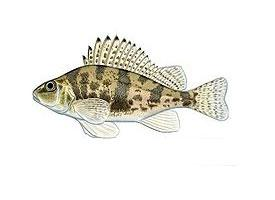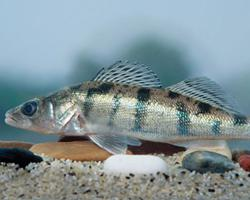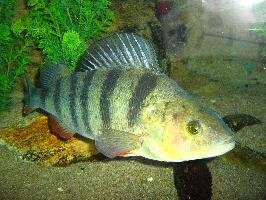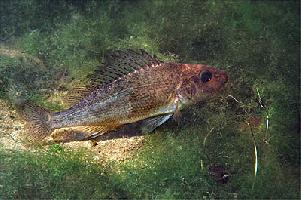
Popis zvířete
Balon's ruffe, scientifically known as Gymnocephalus baloni, is a distinctive and relatively less known species of freshwater fish that belongs to the Percidae family, which also includes perch and darters. This species is named in honor of the eminent ichthyologist Eugene K. Balon, recognizing his contributions to the study of fish biology. Balon's ruffe thrives in the cool, temperate waters of Europe, specifically in regions that offer a balance between flowing and still waters such as rivers, lakes, and reservoirs.Physically, Balon's ruffe is a small to medium-sized fish, with an average length of about 10 to 15 centimeters, though it can occasionally grow larger. It has a distinctive body shape that is somewhat elongated and compressed laterally, allowing it to navigate swiftly through its aquatic habitat. The fish's skin is covered in rough, ctenoid scales that give it a slightly abrasive texture, a feature it shares with other members of its family.
The coloration of Balon's ruffe is particularly noteworthy. It boasts a mottled pattern of dark browns and greens across its back, blending into lighter shades on its belly. This camouflaging coloration provides an excellent defense mechanism against predators, allowing it to blend seamlessly into the substrate and vegetation of its natural habitat. Its dorsal fin is large and spiny, a characteristic defensive feature that, when raised, can deter would-be attackers. This fin, along with the anal and caudal fins, often features subtle hints of reddish or orange hues, especially during the breeding season.
Balon's ruffe has a voracious appetite and is known for its predatory habits. Its diet primarily consists of small invertebrates, including insects, larvae, and crustaceans, though it can also consume small fish and zooplankton. This diet reflects the fish's opportunistic feeding behavior and its role as a significant link within the aquatic food web.
Reproduction in Balon's ruffe involves a fascinating display of nuptial colors and behaviors. Spawning typically occurs in the late spring to early summer when water temperatures reach optimal levels. Males become highly territorial and exhibit vibrant colors to attract females and ward off rivals. Females lay their eggs in carefully selected sites, often among vegetation or in protected crevices, where the male then fertilizes them. The parental investment ends here, as Balon's ruffe does not exhibit any form of parental care post-spawning.
Despite its intriguing characteristics, Balon's ruffe remains relatively obscure in the broader public consciousness. Its habitat preferences and behaviors make it a species of interest primarily to ichthyologists and environmental scientists who study freshwater ecosystems. As with many freshwater species, the conservation status of Balon's ruffe is a concern, with habitat degradation, pollution, and climate change posing significant threats to its populations.
In summary, Balon's ruffe (Gymnocephalus baloni) is a fascinating and somewhat elusive species that contributes to the biodiversity and ecological balance of freshwater ecosystems in Europe. Its unique physical and behavioral traits make it an interesting subject for scientific study, while also highlighting the importance of conservation efforts to ensure the survival of such specialized species in increasingly threatened habitats.
Podobná zvířata
Nové fotografie zvířat
Top 10 zvířat
- Chinese water dragon (Physignathus cocincinus)
- Galápagos tortoise (Geochelone nigra complex)
- Dolphin gull (Leucophaeus scoresbii)
- Japanese macaque (Macaca fuscata)
- Colombian red howler (Alouatta seniculus)
- Sea urchins (Echinoidea)
- Diana monkey (Cercopithecus diana)
- Moustached guenon (Cercopithecus cephus)
- Colossal squid (Mesonychoteuthis hamiltoni)
- Common reed warbler (Acrocephalus scirpaceus)


